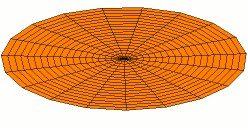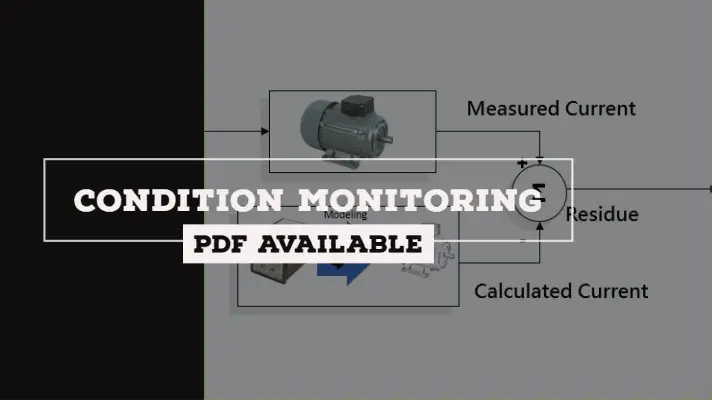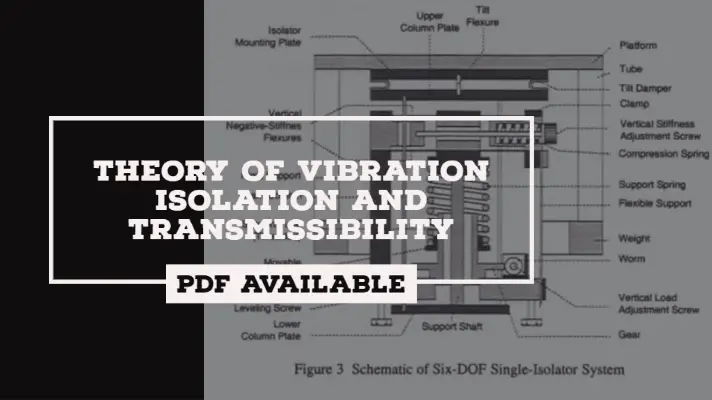Mechanical Vibrations: Definition, Types, and Applications [PDF]

Mechanical Vibrations plays an important role in the field of Automobile Engineering and Structural Engineering. When any sudden disturbance takes place, then the structure should be in a position to tackle that.
Else, the structure fails...
Therefore, In this article, I am providing all the concepts of Vibrations like the definition, types of Mechanical Vibrations, and applications in detail.
Mechanical Vibrations Definition:
Mechanical vibration is defined as the measurement of a periodic process of oscillations w.r.t. an equilibrium point.
Mechanical Vibrations Examples:
Some of the examples of Mechanical Vibrations are as follows.

- Membranes and Plates
- critical speed
- beams
- strings
- balancing of reciprocating machinery
- balancing of rotary machinery
- Vibration Isolation & Transmissibility
Mechanical Vibrations Types:
The Types of Mechanical Vibrations are as follows.
- Damped Forced Vibration
- Damped Free Vibration
- Vibration Monitoring System
- Nonlinear Vibration Methods
- Random Vibration
- Nonlinear and Random Vibrations
- Rotating Unbalancing
An Explanation for the Types of Mechanical Vibrations are as follows.
1. Damped Forced Vibration:
If the external force (i.e mass)is acted upon the system, then the system undergoes vibratory motion and thus called as Forced Vibration on the System.

Explanation of Damped Forced Vibration:
- If the damper is induced within the construction along with the external force acting on the system, then the system is called Damped Forced Vibrations.
- If the damper is induced within the construction with no applied force on the system, then the system is called Damped Free Vibrations.
- The forced vibration is represented as Fcoswt or Fsinwt.
- The equation of motion is represented in the video which is shown below.
- As soon as the harmonic force is applied there will be a transient response coupled with the forced response. The transient part is the one that dies out after some time.
Hence neglecting the transient response, we have
x = Asinwt +Bcoswt
It can also be written as x=Xsin(wt-(fi))
2. Damped Free Vibration:
As the name suggests that the system is Damped, It means a Damper is present in the system which is used to absorb the vibrations.
But the system doesn’t undergo any external force which means the system is under natural vibrations also called free vibrations.
The entire system with all these specifications is called a Damped free vibratory system. In this article, I will be explaining about the Damped Free Vibrations in an effective manner.
Explanation of Damped Free Vibration:
- Free vibrations are oscillations where the total energy stays the same over time.
- This means that the amplitude of the vibration stays the same.
- This is a theoretical idea because in real systems the energy is dissipated to the surroundings over time and the amplitude decays away to zero, this dissipation of energy is called damping.
Thus called a system under “Damped Free Vibrations”.
3. Vibration Monitoring System:
The Vibrations Monitoring system includes Vibration Monitoring, Machine problem detection, Monitoring Benefits, and Advantages of Vibration Monitoring.

Vibration Monitoring:
Monitoring the system during rotation of machinery such as turbines, fans, pumps, etc. exhibit vibrations called Vibration Monitoring.
Vibrations in the system take place for many reasons and some of them are discussed below.
Other details of Vibration Monitoring and its benefits:
Do you know, how the typical problems were detected in a machine during vibrations?
They are shown below.
Machine Fault Detection:
Detecting typical machine problems are as follows.
- Imbalance
- Misalignment
- Looseness
- Rolling element bearing defects
- Gear defects
- Pump cavitation etc.
Monitoring Benefits:
The monitoring benefits are presented below.
- An advance indication of developing problems
- Keep people out of hazardous areas
- Protect health, safety, and environment
- Monitor inaccessible equipment
- Complement portable monitoring programs.
- Vibration magnitude is proportional to the magnitude of the problem.
- Vibration can help to find the location of the fault.
- Vibration can help to find the cause of the fault.
- Vibration measurement is non-invasive.
- Most faults show increased vibrations in an early stage of the deterioration sequence.
- Vibration can be measured instantaneously.
- Vibration can indicate the severity and deterioration rate of a fault.
4. Nonlinear Vibration Methods:
The methods to analyze Non-Linear vibratory systems are as follows. They are
- EXACT Method
- Approximate Analytical Methods
The Approximate analytical methods are further classified into four types and are as follows:
- Poincore method
- Lindsted’s perturbation
- Iterative method
- Phase-plane method
5. Random Vibrations:
- In Mechanical Engineering random vibration is a motion that is non-deterministic, meaning that future behavior cannot be precisely predicted.
- The randomness is a characteristic of the excitation or input, not the mode shapes or natural frequencies.

- Some common examples include an automobile riding on a rough road, wave height on the water, or the load induced on an airplane wing during flight.
- Structural response to random vibration is usually treated using statistical or probabilistic approaches.
- In mathematical terms, random vibration is characterized as a stationary process.
6. Nonlinear and Random Vibrations:
Vibration phenomena that might be modeled well using linear vibration theory include small amplitude vibrations of long slender objects like long bridges, airplanes, wings, helicopter blades, etc.
Nonlinear systems can display behaviors that linear systems cannot. These include:
- Multiple steady-state solutions in which some are stable and some are unstable in response to the same inputs.
- Jump phenomena, involving discontinuous and significant changes in the response of the system as some forcing parameter is slowly varied.
- Response at frequencies other than the forcing frequency.
- Internal resonances, involving different parts of the system vibrating at different frequencies, all with steady amplitudes (the frequencies are usually in rational ratios, such as 1:2, 1:3, 3:5, etc.)
- Self-sustained oscillations in the absence of explicit external periodic forcing.
- Complex, irregular motions that are extremely sensitive to initial conditions.
Applications of Non-linear and Random Vibrations:
The applications of Non-linear and Random vibrations are as follows.
- Small rocking motions of ships in calm waters
- The simplest whirling motions of flexible shafts
- Interactions between bridges and foundations
- Interactions between wings/blades and air
- Interactions between ships and waves
- Interactions between shafts and bearings and so on are all nonlinear.
7. Rotating Unbalancing:
Rotating Unbalance is the uneven distribution of mass around an axis of rotation. A rotating mass or rotor is said to be out of balance when its center of mass is out of alignment with the center of rotation (geometric axis).

Explanation of Rotating Unbalance:
Unbalance causes a moment which gives the rotor a wobbling movement characteristic of vibration of rotating structures.
It mainly focuses on
- Inherent unbalance in the systems
- Vibrations due to Reciprocating mass of engines
- Critical or whirling speeds of an eccentric rotor mounted on the shaft.
Effects of Unbalance:
The effects of unbalance are as follows.
- Unsafe work conditions
- Vibrations
- Decreased life of bearings
- Increased maintenance
- Reduced machine life
- Noise
Applications of Mechanical Vibrations:
The applications of Mechanical Vibrations are as follows.
- Identification of the system: If you want to calculate the mass, stiffness and damping of a vibratory system then you need to do the vibration analysis which is used in structural health monitoring.
- Design of components: When you are designing the components of an automobile, you need to look at the consideration that the vibrations exited by the engine should not match with the other components and if it does, there may be a chance of failure like loosening of bolts etc.
This is the detailed explanation on the topic of Mechanical Vibrations. If you have any doubt, you can ask us and I will give you the reply as soon as possible.
More Resources:
Theory of Vibration Isolation and Transmissibility
Condition Monitoring
References [External Links]:
- Mechanical Vibrations-Purdue Engineering



